
 |
|||||
|
|
|||||
|
|
|
|||||
|
|
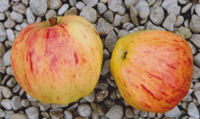 |
FLOWER OF THE TOWN All the early references for this apple are under the name Flowery Town and this should be the correct name. There is a little suspicion that Flower of the Town might once have been a different apple, though this has become the name in use with Flowery Town having become a synonym. The change came about between the 1826 and 1842 catalogues of the London Horticultural Society, for no discernible reason. In 1883, it was exhibited as Flowery Town by Mr Charles Crossland, the Gardener at Beachwood, Arnside, Westmorland, at the National Apple Congress. He reported that “the apples I have sent may not be as fine as might be anticipated, but as they are gathered from such old trees, much finer could not be expected”. The Congress observed that the examples were all small, very deficient in colouring, being green and unripe looking, and all more or less acid. Mr Crossland noted (in 1883) that all the apples he exhibited had been grown on the Beachwood Estate for over 200 years, presumably from records kept by Mr Saul, a former owner of Beachwood. That would put the age of this apple at pre-1683. Other early references came from a listing in a bill of sale from Bealy and Sons, a Blackburn Nursery, in 1814 as Flowery Town (as reported by Philip Rainford) and in 1816 it was listed in the Backhouse Nursery catalogue at York, as Flowery Town. In 1834 it was in the list of Alexander Willison, Nurseryman at Whitby. It has long been associated with Yorkshire, but the two earliest references are from Westmorland and Lancashire. The 1842 LHS collection catalogue described it as a medium sized, streaked, roundish, for kitchen use, of middle quality and in use from September to November. It added ‘indifferent in quality tho’ a good bearer’. In 1872 it was listed in the supplement to Scott’s ‘The Orchardist’. The report of the 1883 National Apple Congress described it as for culinary use, medium sized, flat, angular, green, streaked, acid and late (though it had been accepted that the samples were poor). In modern times an apple of this name was in the National Fruit Trials and later the National Collection. It was judged to be false and replaced, but might previously have escaped into cultivation. The true apple was still known and has now been taken to the National Collection. Our own scions came from John and Helen Hempsall of East Markham, Nottinghamshire. The apples are really prominently angular, but regularly so, with a pleasing polygonal section. Wider than taller, the skin develops a warm yellow when ripe in October, delicately and often fully striped with scarlet. The flesh is crisp, juicy, sweet, yet pleasantly acid, and richly flavoured. In the north, in some years, it might be better suited to culinary use, but in the south it is an excellent dessert apple, of almost unique shape. Pollination Group 5 |
||
 |
FORGE Also known as Cottager's Apple, Cottager’s Friend and Sussex Forge, it was first described in 1851 in Hogg’s ‘British Pomology, though it had long been known in its native Sussex. Hogg’s account of 1851 is the most revealing (though he wrote of it again in 1884, in ‘The Fruit Manual’) when he said “A beautiful and valuable apple, suitable either for the dessert, culinary use, or for the manufacture of cider. It is in use from October to January. The tree attains about the middle size, is perfectly hardy and healthy, and quite free from canker and disease. It is a most abundant and regular bearer. I am surpised that this beautiful apple has hitherto escaped the notice of pomologists, it being so universally grown, and generally popular, in the districts to which it belongs. In the north-eastern parts of Sussex, and the adjoining county of Surrey, it is extensively cultivated, and I believe there is scarcely a cottager’s garden where it is not to be met with, nor is there a cottager to whom its name is not as familiar as his own, it being considered to supply all the qualifications that a valuable apple is supposed to possess; and although this judgement is formed in contrast with the other varieties grown in the district, nevertheless, the Forge is a useful and valuable apple, particularly to a cottager, whether we consider its great productiveness, its uses as a dessert and excellent cooking apple, or the excellent cider which it produces. It is said to have originated at a blacksmith’s forge near East Grinstead.” In 1884 Hogg changed the origin to “It originated at Forge Farm, near one of the old forges in the iron districts of Sussex, near Crawley.” He was right in his praise. The apples are rounded, slightly flattened, obscurely ribbed and with skin of pale green turning yellow, with broad flushes and flecks of full red, over orange. The flesh is crisp, juicy, sweet and rich with a good tang of acid. Ripe in late September, the apples will keep to the year end, though they are at their best before the end of November, when they lose some flavour, though they stay moist and sweet. A good cropper. Pollination Group 5 |
|||
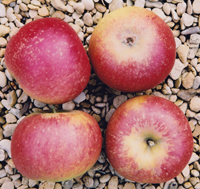 |
FORSYTH’S
SERPENT A very old tree, now well advanced in its renewal from
a fallen ancient tree, having become two new trees, 6 yards apart. It
grows just 100 yards away from our nursery entrance, at a cottage once
part of Wotton Estate. It was shown to us by the late Mr and Mrs Forsyth,
the owners, in the late 1990s. Incidentally, Mr Forsyth was a direct descendent
of William Forsyth, gardener to George III and famed author of ‘A
Treatise on the Culture and Management of Fruit Trees’. The medium
to large apples are brightly coloured red, with russet spots and though
late to ripen they are worth the wait, becoming beautifully sweet, crisp,
juicy and fine fleshed. They are also very good cooked, keeping their
shape with a sweet rich flavour, in no need of added sugar. Ripe in late
October, the fruit will last in good condition into the New Year. Named
by us, the Serpent suffix comes from the shape of the tree when first
seen. The fallen tree had bedded into the soil and the bends on the trunk,
after decaying and sinking, resembled a serpent dipping in and out of
water. Pollination Group 4 |
|||
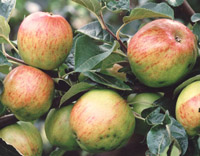 |
FORTY
SHILLINGS A dessert apple known before 1800 and assumed local
to Cumberland and Westmorland. The first record appears to be in the 1798
catalogue of Clark and Atkinson, Nurserymen of Keswick, Cumberland and
Keighley, Yorkshire. They listed ‘Worcester 40 Shillings’
as a baking apple (and though the apple now known is a dessert apple,
in those times every apple was cooked). In line with others, we have previously
listed this apple with the illogical and ungrammatical name of ‘Forty
Shilling’. We now have the earliest reference, listing it under
the more sensible name of Forty Shillings.The National Fruit Trials received
scions in 1950 from a tree believed to have been planted in 1880 at Thursby,
near Carlisle. A dessert apple of medium size, and middle season, from
September to October. A tall to truncate conic, convex shape, slightly
ribbed on the body and around the eye. The skin is pale greenish-yellow,
flushed brownish-red and striped with deeper red, netted with russet.
The flesh is juicy, crisp, and sweet, with the right amount of acid and
a pleasing flavour. Pollination Group 4 |
|||
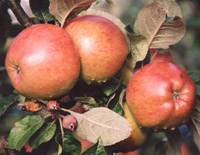 |
FOULDEN
PEARMAIN Introduced in 1818 by George Lindley, famed nurseryman
of Norwich, having arisen in the garden of Mrs Horrex of Foulden, Norfolk.
It was in the London Horticultural Society collection in 1826. A dual
purpose, medium sized, oblong apple, having skin of pale yellow heavily
blushed and streaked bright red. In October, the flesh is very crisp and
very juicy, but yielding. It is sweet, without much acid but with a full
flavourn and very refreshing. The apples will last into the winter. Our
thanks to John and Helen Hempsall, East Markham, Nottinghamshire, for
sending scion-wood. Pollination Group 3 |
|||
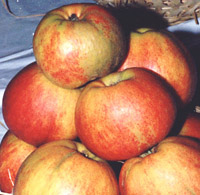 |
FOULKES’
FOREMOST A middle season late dessert apple, the seed sown in
1938 by Mr F. Foulkes of Headington, Oxford, from a foreign apple. It
is large, slightly flattened round and occasionally conical, with slight
ribs. The skin is yellow green with a brownish red flush and dull red
streaks. The flesh is firm and tender, sweet and rich with good acidity
and moderate juice. A very good apple here, ripe in early-middle September,
but usually not lasting well after November, though sometimes in December
it can be very sweet with the flavour of prunes. Attractive rose pink
blossom. Pollination Group 3 |
|||
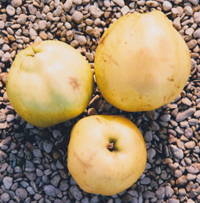 |
FOXTON
FOUNDLING Foxton in Leicestershire is a very interesting place
and, back in 2014, when Stephen and Linda Butt were living there they
had a small piece of land which they used as an allotment. It came with
a single, very old apple tree. Possibly, this tree was one of those rarities
from the nurseries of the Reverend William Hanbury. As we have recounted
under some other entries in our catalogue, he was one of the truly great
and one of the very few authoritative writers on gardening of his age.
His ‘A Complete Body of Planting and Gardening...’ in 1770,
was written from real experience, rather than from repeating the already
repeated words of others. He set up plant nurseries in his area and used
the proceeds exclusively for improvements locally - notably the Church
and a new school. His descriptions of apples could not have been written
without great familiarity with them. His varieties hark back to names
known in the 17th century or early 18th, rather than new names that were
becoming known late in the 18th century. His base was at nearby Church
Langton, the next village away. Stephen counts himself a historian rather
than a horticulturist but he is very familiar with Hanbury. Over thirty
years ago he produced a radio programme about Hanbury, with an actor playing
the man himself and using extracts from Hanbury's diaries. Stephen reports
that Hanbury was active in the Foxton area, cultivating numerous shrubs
and trees, including some apple varieties and he is convinced that some
of the terraced field boundaries in Foxton are nursery areas where Hanbury
planted out his shrubs and saplings, and knows from Hanbury’s diaries
that he had nurseries in Gumley, which is just a few miles further on.
Stephen and Linda presented us with the 1892 Ordnance Survey map, which
showed the location of their tree and also revealed that nearly half of
Foxton was orchards. The small piece of land that harbours the apple tree
was probably a 'pightle', - land that wasn't ‘enclosed’ because
of its awkward shape, according to the Butts. It was given to the minister
of the local Methodist church in exchange for some land he gave up at
the time of enclosure (1770). Many years later, he sold it on. It was
an apple orchard at the time of the first OS map, so it is possible that
the use of the land changed little from Hanbury's time until the present
day. The tree seems to have had a very major bough or division of the
trunk removed from low down after it reached significant size, but leaving
two major boughs that now look like two trunks, very close to the ground.
This is abnormal and might suggest that ground level has been made up
by some distance. After we suggested this to Stephen and Linda they confided
that they had come to the same suspicion because other trees on the site
looked 'waist-high'. They observed that the stream at the bottom of the
site, away from the apple, is part of the water management system for
Foxton Locks. After prolonged rainfall, when water is released from the
canals, it rushes through the site, so much so that the road outside becomes
flooded (or possibly reverts to being a ford). Making up ground level
around the site would seem logical. Also, we are looking at an age when
the Grand Union Canal was created and earth excavated for the locks, canal
and reservoirs had to go somewhere. Some very heavy clay is on the site!
Stephen checked on the dates and the locks were completed in 1814 having
taken four years to construct. Stephen’s knowedge extends to canals
and he says that the main challenge for the designers was the lack of
water at this level of the Grand Union Canal. Hence they created a sequence
of ponds to save water. Each of the ten locks emptied into a pond, and
the water was used to fill them back up, depending on the direction of
the boats. ‘My view is that the pond excavations must have created
a considerable amount of spoil, some of which may have ended up on our
site’. If the level of the site was raised and the old tree trunk
was buried, and if the soil/clay came from the creation of the Grand Union,
then this tree should be older than 1814. The apples from this tree are
similar to Catsheads but they do not have hollow cores and are without
Catshead’s warm blush. Apples are large, with a small waist, yellow
when fully ripe from late September to early November, ribbed, and becoming
sweeter as they age. They are very sweet and pleasantly flavoured to eat
raw when fully ripe. When cooked, the apple keeps some of its shape but
is inclined to become a purée, becoming very rich, with a nice
tang and sweet enough without any need to add sugar. A very good and very
old tree. Pollination Group 5 |
|||
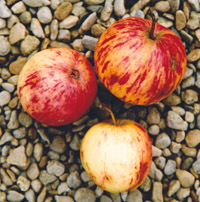 |
FOXWHELP
A cider apple, first mentioned by Evelyn in his Pomona in 1664 and second
in popularity, then, only to the Redstreak. Though long considered a Herefordshire
apple, Evelyn’s Pomona suggests it was originally a Gloucestershire
apple that spread to Herefordshire. Hogg records that by 1727 the Fox-Whelp
was greatly valued and apparently more famous than the Redstreak, and
cider made from it was deemed of equal value to French wine; thought to
improve with age. A small to medium sized apple, rounded and ribbed, often
conical, ending in ridges at the eye. In the shade it is yellow, but prettily
striped and flushed in the sun, with crimson. The flesh is moderately
sharp, sometimes tinted red, and aside from being a good cider ‘sharp’
it also makes good apple sauce. There have been several different ‘Foxwhelps’
produced over the centuries, but the original appears to have survived.
Ripe in October, it will last into January with care. Pollination Group
3 |
|||
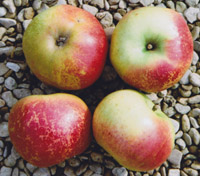 |
FRANCATU
Assumed to be a French apple, dating from 1536 when recorded by Ruel,
and undergoing various name changes over the centuries. However, it was
known in England very early, when Charles Cotton included it in ‘The
Planters Manual’ of 1675 as Francatu. Switzer in 1731 in ‘The
Practical Fruit-Gardener’ mentions francatuses as French apples.
It was in the London Horticultural Society collection in 1826 and grown
by Ronalds in 1831, but has not been heeded much since. It is in the National
Collection here and in France. A medium sized, late season apple, rich
green, broadly flushed with crimson and marbled and cracked with russet.
The flavour is very rich, sweet and pleasantly acid in late October, keeping
to January. Pollination Group 5 |
|||
FREDDIE’S
SPECIAL A few years ago, we were informed of an apple in Stewkley,
Buckinghamshire, by Michael Chappell, whose family all lived in the village,
past and present. At one time, his great, great grandfather owned much
of Stewkley and planted many of these trees around the village. Michael
wanted us to produce a new tree for him, to be planted at the Stewkley
Nature Reserve. There are still two old trees of ‘Freddie’s
Special’ alive in Stewkley and Michael showed us the one behind
the Chapel, which was planted by his great grandfather, who was called
Frederick Edward Chappell, probably early in the 20th century. The apple
had always been known as Freddie’s Special. We took cuttings for
new grafts from the tree behind the Chapel. It is a late season eating
apple with white flesh which does not discolour when cut. It is crisp,
sweet and very juicy, and with shiny skin brightly coloured red. It will
store until late in the year and into next. Pollination Group 7 |
||||
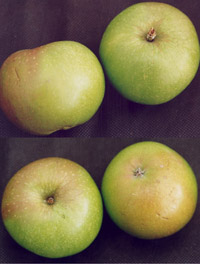 |
FRENCH
CRAB Grown in England since the 1700s. A top quality cooking
apple, with dark green skin, which cooks to a full flavoured stiff purée.
Forsyth, writing at the beginning of the 19th century called it a first
rate dessert apple, when fully ripe. It was once known as ‘Old Ironsides’,
or ‘The Two Year Apple’, because of its hardness and exceptional
storing qualities. Rogers (1837) said that large quantities were brought
over from Normandy, for sale in Covent Garden. He makes French Crab the
same as the ancient Deux Ans, but other authors have different views about
Deux Ans. In the 19th century it was assumed the same as Winter Greening
– and Hogg thought Winter Greening the earlier and correct name
– but the full history suggests they are distinct apples. We also
have the Winter Greening of Joy Midwinter (see later). We believe French
Crab is not the same as Winter Greening. A heavy, hard, medium sized apple
that only reveals its true quality after storage. It has also been used
for cider. Vigorous trees with good crops. Pollination Group 5 |
|||
|
||||